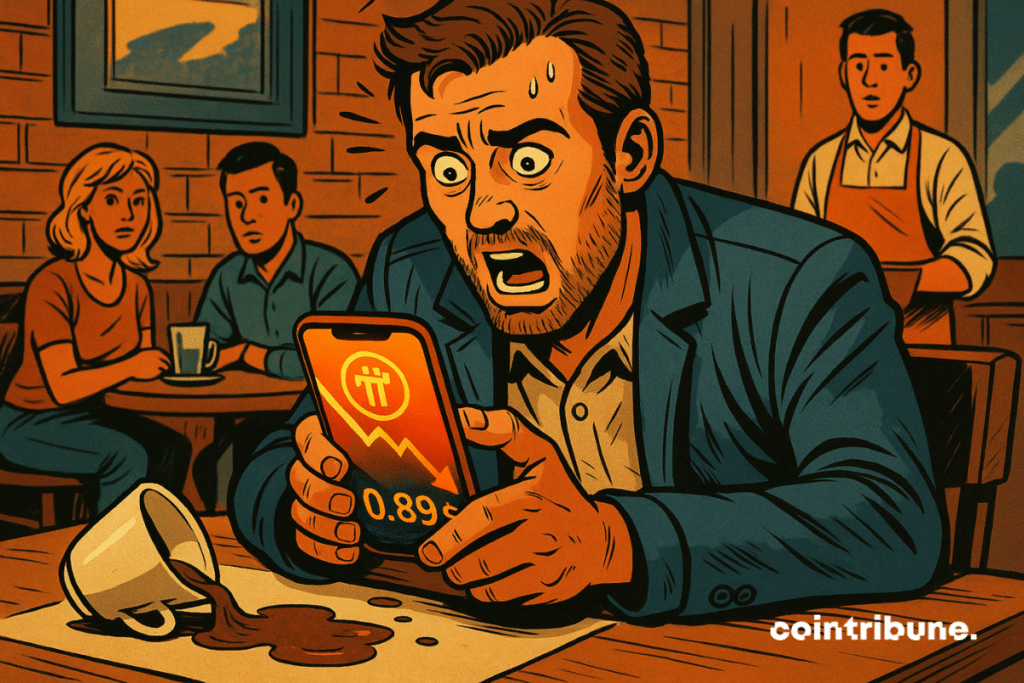Pi Network’s Token Tanks as Skeptics Question Its ’Mine-From-Phone’ Miracle
Another day, another crypto ’revolution’ showing cracks in its foundation. Pi Network—the project that lured millions with promises of smartphone mining—just saw its token price crater amid mounting transparency concerns.
Where’s the blockchain? Critics point to Pi’s closed mainnet and centralized distribution as red flags. Meanwhile, retail miners keep tapping that lightning bolt button daily—because nothing builds confidence like a token that can’t even be traded on most exchanges.
Finance veterans shrug: at least this isn’t another celebrity meme coin. Probably.

In brief
- The Pi token has collapsed by more than 75 % since its launch in February 2025, falling below the symbolic threshold of $1.
- Many investors still do not have access to their tokens due to ongoing KYC validation issues.
- The project is still not listed on major exchange platforms like Binance or Coinbase, despite a market capitalization exceeding $5 billion.
- The community expresses growing concern over the lack of transparency and deliverables from the founding team.
From initial enthusiasm to a 75 % drop
Officially launched in February 2025 after five years of development and community mining via a mobile app, the PI Network mainnet sparked excessive expectations. The PI token had a spectacular start, briefly reaching $2.98, a level hailed as a victory by the community.
However, this positive momentum was very quickly hampered by a series of malfunctions that slowed effective network adoption. The first problem after launch concerned locked coins and the inability of many mining specialists to claim their tokens due to KYC issues.
A frustrating situation for investors who had been involved for sometimes five years, which tarnished the image of a launch supposed to mark a new era.
In the weeks that followed, the token lost more than 75% of its value and fell well below the symbolic $1 mark, despite an ephemeral rebound above $1.20. This development reflects a lack of solid economic and technical fundamentals. Added to this are a series of critical signals :
- Funds blocked : thousands of users still cannot access their Pi due to unvalidated or incomplete KYC procedures ;
- Extreme price volatility : in the absence of real market support, the Pi Network price remains subject only to speculation;
- A rapid drop in perceived capitalization : although the project still shows capitalization above 5 billion dollars, trust is declining ;
- No listing on major platforms : despite its size, Pi Network is still not listed on Binance, Coinbase, or other major exchanges.
These facts mark a chaotic start for a project which, on paper, had everything to attract a large portion of the general crypto public. It remains to be seen if the team can regain control over communication and restore confidence amid growing skepticism.
Transparency challenged and absence of network activity
While the project boasts a capitalization of over 5 billion dollars and is now ranked in the top 30 cryptos, its absence from major exchange platforms like Binance or Coinbase raises questions.
Community members have speculated that the team’s actions might be the cause of this lack of listing. The reason WOULD be an alleged lack of transparency from the Pi Network team, a criterion that is essential for major exchanges.
Without clear communication on governance structure, actual allocation of tokens, or security audits, potential institutional partners remain at a distance.
Furthermore, there is also a total absence of DeFi applications or activity on the main network. No lending platform, no DEX, no smart contract deployed to date, leaving the blockchain without a concrete use case.
The Pi Ventures project, endowed with an announced fund of 100 million dollars to support Web3 startups, remains to date without official announcements or proof of activity. So far, there has been no development showing any growth.
These structural gaps cast increasing doubt on the project’s viability. While the community remains large and active, the lack of concrete results could shift collective opinion. Without quick action to restore trust through credible listings, DeFi announcements, or concrete deliverables, the risk is high that Pi Network will be relegated to the status of a project with high potential but failed execution.
Maximize your Cointribune experience with our "Read to Earn" program! For every article you read, earn points and access exclusive rewards. Sign up now and start earning benefits.

